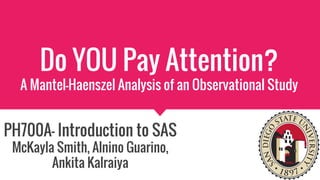Report
Share
Download to read offline

Recommended
Recommended
More Related Content
What's hot
What's hot (10)
Writing Introduction for Manuscript (scientific writing)

Writing Introduction for Manuscript (scientific writing)
Research Design (Research Types, Quantitative Research Design and Qualitative...

Research Design (Research Types, Quantitative Research Design and Qualitative...
Observational Research designs: detailed description 

Observational Research designs: detailed description
Similar to PH700A- Group Project
Similar to PH700A- Group Project (20)
A Framework for Statistical Simulation of Physiological Responses (SSPR).

A Framework for Statistical Simulation of Physiological Responses (SSPR).
Math, Stats and CS in Public Health and Medical Research

Math, Stats and CS in Public Health and Medical Research
Feedback for 6-2 Milestone Three Methodology, Design, and Data.docx

Feedback for 6-2 Milestone Three Methodology, Design, and Data.docx
Week 6 Assignment 2Application Chi-Square Study.docx

Week 6 Assignment 2Application Chi-Square Study.docx
CORE: Quantitative Research Methodology: An Overview

CORE: Quantitative Research Methodology: An Overview
Working correlation selection in generalized estimating equations

Working correlation selection in generalized estimating equations
PH700A- Group Project
- 1. Do YOU Pay Attention? A Mantel-Haenszel Analysis of an Observational Study PH700A- Introduction to SAS McKayla Smith, Alnino Guarino, Ankita Kalraiya
- 2. Hypothesis/Rationale There is an ASSOCIATION between sitting in the front of the classroom and paying attention with sex being a confounder. Confounder?
- 3. Background ● Being current students at SDSU, we wish to investigate and uncover differences in gender and whether or not sitting in the front of the class impacts one’s ability/desire to pay attention. ● There is LIMITED current literature addressing topic.
- 4. Study Design Observational study conducted over 7 graduate level public health courses at San Diego State University
- 5. Methods- Population, Variables, Possible Confounder Study population: college students → graduate level Public Health 601, 602, 603, 604, 605, 621 Independent Variables: level of attention given (actively paying attention, not paying attention), sitting position (first 3 rows of class, rear) Possible confounder: sex (male, female)
- 6. Methods- Mantel-Haenszel Chi-Square Analysis ● SAS 9.4 ● Crude odds ratio ● Stratum-specific odds ratio by sex ● Breslow-Day test of homogeneity to test equality of the stratum specific odds ratios ● Adjusted odds ratio ● Confidence intervals
- 7. SAS Log 1 proc import datafile="D:PH700A Final Project.xlsx" DBMS=excel OUT=project REPLACE; 2 run; NOTE: WORK.PROJECT data set was successfully created. NOTE: The data set WORK.PROJECT has 237 observations and 3 variables. NOTE: PROCEDURE IMPORT used (Total process time): real time 0.76 seconds cpu time 0.17 seconds 3 proc format; 4 value positionfmt 1="front" 2="back"; NOTE: Format POSITIONFMT has been output. 5 value sexfmt 1="female" 2="male"; NOTE: Format SEXFMT has been output. 6 value attfmt 1="yes" 2="no"; NOTE: Format ATTFMT has been output. 7 run; NOTE: PROCEDURE FORMAT used (Total process time): real time 0.09 seconds cpu time 0.04 seconds 8 proc freq data=project; 9 tables position sex attention; 10 format position positionfmt. sex sexfmt. attention attfmt.; 11 tables position*attention/measures; 12 tables sex*position*attention/CMH; 13 run; NOTE: Writing HTML Body file: sashtml.htm NOTE: There were 237 observations read from the data set WORK.PROJECT. NOTE: PROCEDURE FREQ used (Total process time): real time 1.50 seconds cpu time 0.36 seconds 14 proc sort; 15 by sex; 16 run; NOTE: There were 237 observations read from the data set WORK.PROJECT. NOTE: The data set WORK.PROJECT has 237 observations and 3 variables. NOTE: PROCEDURE SORT used (Total process time): real time 0.03 seconds cpu time 0.03 seconds 17 proc freq data=project; 18 tables position*attention/measures; 19 by sex; 20 run; NOTE: There were 237 observations read from the data set WORK.PROJECT. NOTE: PROCEDURE FREQ used (Total process time): real time 0.07 seconds cpu time 0.01 seconds
- 8. Results- Descriptive Statistics Position ● Front: 116- 48.95% ● Back: 121- 51.05% Those who Pay Attention ● Yes: 177- 74.68% ● No: 60- 25.32% Sex ● Female: 138- 58.23% ● Male: 99- 41.77% Total sample size = 237
- 9. Results- Crude Odds Ratio Crude OR: 2.1516 The odds of sitting in the front and paying attention are 2.1516 times as likely as sitting in the front and not paying attention. CI (1.1723, 3.9488)
- 10. Results- Stratum-Specific OR (Female) Female OR: 1.8985 Odds of being female in the front and paying attention are 1.8985 times as likely as being a female sitting in the front and not paying attention. CI (0.8555, 4.2135) Sex= 1 (Female)
- 11. Results- Stratum-Specific OR (Male) Male OR: 2.5107 Odds of being male in the front of class and paying attention are 2.5107 times as likely as being a male in the front of class and not paying attention. CI (0.9744, 6.4696) Sex= 2 (Male)
- 12. Results- Breslow Day Test for Homogeneity ● p-value (0.6578) → fail to reject null that the stratum specific odds ratios are equal ● Adjusted odds ratio (2.1372) not more than 10% different from crude odds ratio → we report crude odds ratio (2.1516)
- 13. Conclusion/Major Findings Crude odds ratios = adjusted odds ratios… ● Sex is NOT a confounder in whether sitting position is independent of paying attention. ● REJECT original hypothesis.
- 14. Questions?